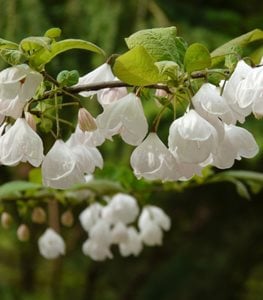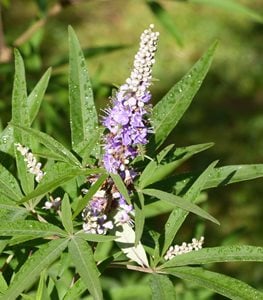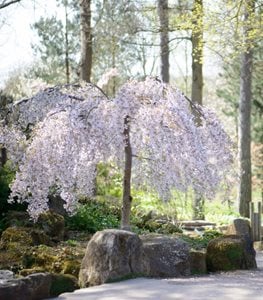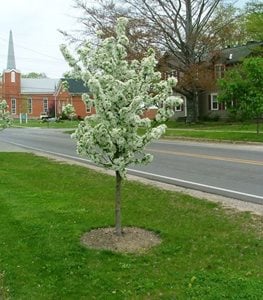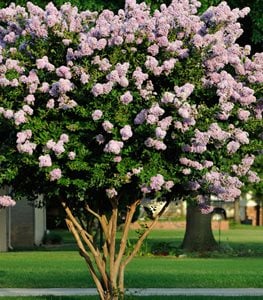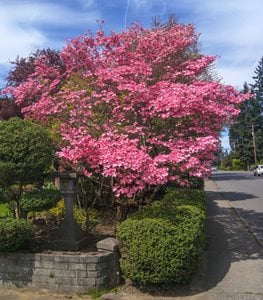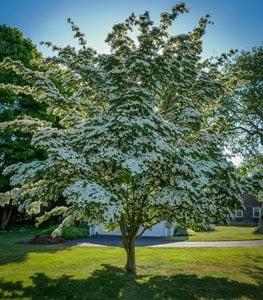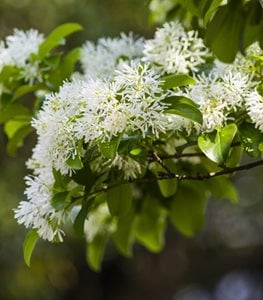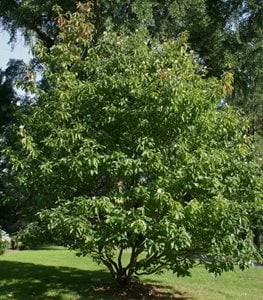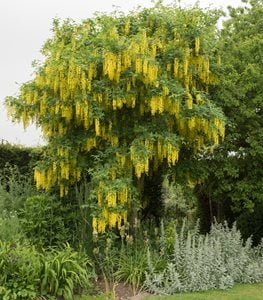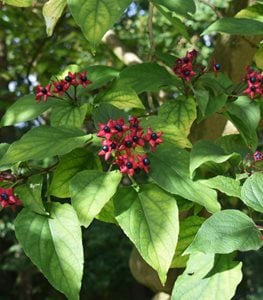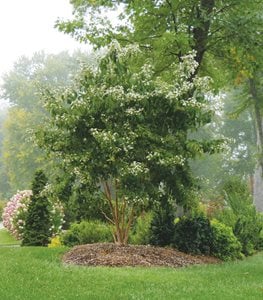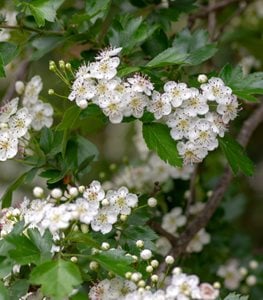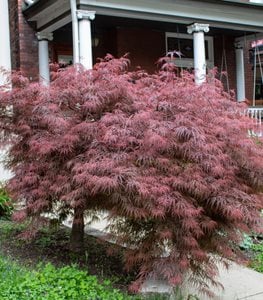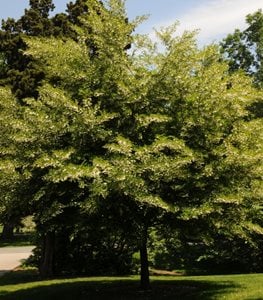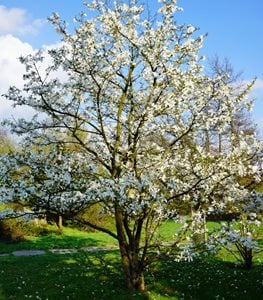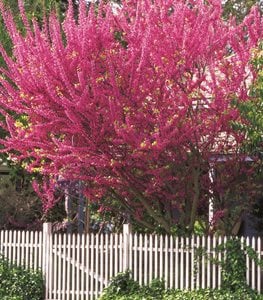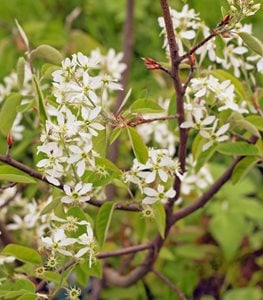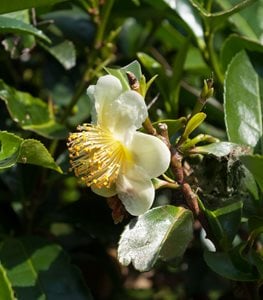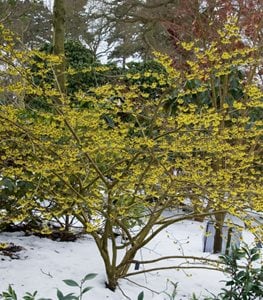Best Small Trees to Grow
Plant smaller trees in your yard that won’t outgrow their space Published 9/13/2022With more people living in urban areas and lot sizes shrinking, smaller-sized plants have become more popular than ever. Trees are an essential part of any landscape, providing structure, cooling shade, and habitat for birds and other wildlife. There are many small trees that offer these benefits without outgrowing the space where they are planted.
While there are no hard and fast rules as to what constitutes a small tree, the Arbor Day Foundation defines small trees as those that grow up to 30 feet tall. Some are naturally small, while others are dwarf varieties of larger trees. Here are some of the best small trees to grow.
CAROLINA SILVERBELL (Halesia carolina)
Zones: 4-8
Exposure: Full sun to partial shade
Growth habit: Upright habit
Height/Spread: 30 to 40 feet tall, 20 to 35 feet wide
Bloom time: Spring
Native to the southeastern U.S., this understory tree is named for its natural range and the nodding white bell-shaped flowers that appear in spring. Oval green leaves turn yellow in fall, while the furrowed reddish-brown bark adds winter interest. May be grown as a tree form or multi-stemmed shrub.
CHASTE TREE (Vitex agnus-castus)
Zones: 6-9
Exposure: Full sun
Growth habit: Upright spreading habit
Height/Spread: 4 to 20 feet tall, 4 to 15 feet wide
Bloom time: Mid to late summer
Chaste tree, which grows as a small tree or shrub, produces showy violet-blue flower spikes. Although the bloom time is short, it is a spectacular show. The deciduous foliage looks similar to hemp, with broad palm-shaped leaflets. Flowers and foliage are fragrant. Use as privacy screening in a small yard or in a mixed border.
Learn more about growing chaste trees.
WEEPING HIGAN CHERRY (Prunus pendulata ‘Pendula Rosea’ )
Zones: 5-8
Exposure: Full sun to partial shade
Growth habit: Upright weeping habit
Height/Spread: 15 to 20 feet tall and wide
Bloom time: Early spring
Rose-pink buds open to pale pink blossoms in early spring before the leaves emerge. Dark green foliage turns brilliant red or yellow in fall, while the graceful weeping habit adds year-round structure. Use as a stand-alone focal point, or in an Asian-style landscape.
Learn more about growing flowering cherry trees.
SWEET SUGAR TYME® CRABAPPLE (Malus spp.)
Zones: 4-8
Exposure: Full sun
Growth habit: Upright spreading habit
Height/Spread: 10 feet tall and wide
Bloom time: Spring
Snow-white flowers appear in abundance in early spring, followed by rich green foliage. Clusters of bright red fruit persist into winter, providing food for birds and other wildlife. Use as a focal point or in a small space.
Learn more about growing crabapple trees.
CRAPE MYRTLE (Lagerstroemia indica)
Zones: 6-10
Exposure: Full sun
Growth habit: Vase-shaped habit with a single or multi-stemmed trunk
Height/Spread: 10 to 30 feet tall, 10 to 20 feet wide
Bloom time: Mid-summer to fall
Crape myrtle is a deciduous tree that offers year-round interest, with showy flower clusters, brilliant fall foliage, exfoliating bark, and attractive structure that lends winter appeal. Flower colors are pink, red, lavender, magenta, or white. Use as a focal point, in a curbside planting, or mixed border. Dwarf varieties are suitable for containers.
Learn more about growing crape myrtle trees.
FLOWERING DOGWOOD (Cornus florida)
Zones: 5-9
Exposure: Full sun to partial shade
Growth habit: Upright spreading habit
Height/Spread: 15 to 30 feet tall and wide
Bloom time: Spring
Flowering dogwood is a popular tree, native to eastern North America, with four-petaled white or pink blooms that occur in spring before the leaves emerge. Bright red fruits mature in late summer, with the green foliage turning purple in fall. Plant as a street tree, stand-alone specimen or in a woodland border.
Learn more about growing dogwood trees.
KOUSA DOGWOOD (Cornus kousa)
Zones: 5-8
Exposure: Full sun to partial shade
Growth habit: Upright vase-shaped habit
Height/Spread: 15 to 30 feet tall and wide
Bloom time: May to June
This Asian native produces showy white, pink, or pale green flower bracts in late spring to early summer, with large strawberry-like fruits that develop after flowering. Deciduous foliage is green or variegated, with scarlet or purple fall color. Use in a formal or Asian-style landscape.
Learn more about growing dogwood trees.
FRINGE TREE (Chionanthus virginicus)
Zones: 3-9
Exposure: Full sun to partial shade
Growth habit: Upright spreading habit
Height/Spread: 12 to 20 feet tall and wide
Bloom time: Late spring to early summer
Native to the southeastern U.S., this hardy deciduous tree is named for the fragrant white fringe-like flowers. Female specimens produce black olive-like fruits, providing food for birds and other wildlife. Green lance-shaped foliage turns yellow in fall. Plant as a focal point, in a mixed border, or native landscape.
FRANKLIN TREE (Franklinia alatamaha)
Zones: 5-8
Exposure: Full sun to partial shade
Growth habit: Upright spreading habit
Height/Spread: 10 to 20 feet tall, 6 to 15 feet wide
Bloom time: Mid to late summer
Franklin tree, a southeastern U.S. native that is now extinct in the wild, is revered for its elegant stature and white camellia-like flowers, which are sweetly fragrant. Deciduous oblong green leaves turn shades of purple, red, and orange in fall. Use as a stand-alone specimen or in a mixed border.
GOLDEN CHAIN TREE (Laburnum x watereri)
Zones: 5-8
Exposure: Full sun to partial shade
Growth habit: Upright spreading habit
Height/Spread: 15 to 30 feet tall and wide
Bloom time: Late spring to early summer
Golden chain tree is named for the long hanging clusters of yellow pea-like flowers that appear in late spring. The wisteria-like flowers are followed by bean-like pods that persist into fall. Plant as a single specimen, train as an espalier, or along an arbor or pergola.
HARLEQUIN GLORYBOWER (Clerodendrum trichotomum)
Zones: 7-10
Exposure: Full sun to partial shade
Growth habit: Upright spreading habit
Height/Spread: 10 to 20 feet tall and wide
Bloom time: Mid-summer to early fall
This deciduous tree or shrub is grown for its multi-seasonal attributes. Clusters of fragrant white star-shaped flowers are followed by metallic blue berries surrounded by bright red calyces. Also known as peanut butter tree for the scent when the heart-shaped leaves are crushed. Use as a street tree or focal point. May be invasive in some areas.
SEVEN SON FLOWER (Heptacodium miconioides)
Zones: 5-9
Exposure: Part to full sun
Growth habit: Upright vase-shaped habit
Height/Spread: 10 to 20 feet tall; 8 to 10 feet wide
Bloom time: Summer through fall
Seven-son flower is a versatile shrub, often grown as a small tree, prized for its year-round appeal. With fragrant white flowers in late summer, vibrant red bracts in fall, and exfoliating bark in winter, it adds beauty to every season while attracting pollinators to your garden.
Learn more about growing seven son flower trees.
ENGLISH HAWTHORN (Crataegus laevigata)
Zones: 5-8
Exposure: Full sun
Growth habit: Upright spreading habit
Height/Spread: 15 to 25 feet tall and wide
Bloom time: Spring
Grown as a small tree or large shrub, English hawthorn produces white, pink, or red flowers in spring, followed by red fruits in fall. Named for the thorny branches, this deciduous tree is tolerant of different growing conditions, making it a good choice for difficult sites. Use as a specimen or street tree.
Learn more about growing hawthorn trees.
CRIMSON QUEEN JAPANESE MAPLE (Acer palmatum var. dissectum)
Zones: 5-8
Exposure: Full sun to partial shade
Growth habit: Compact weeping habit
Height/Spread: 8 to 10 feet tall, 10 to 12 feet wide
There are hundreds of different varieties of this popular ornamental tree. ‘Crimson Queen’ has a weeping habit and deeply dissected foliage. Burgundy red leaves hold their color throughout summer, turning bright orange-red in fall. Use in a container, or as a focal point in a woodland or Asian-style landscape.
Learn more about growing Japanese maple trees.
JAPANESE SNOWBELL (Styrax japonicus)
Zones: 5-9
Exposure: Full sun to partial shade
Growth habit: Upright spreading habit
Height/Spread: 20 to 30 feet tall and wide
Bloom time: Late spring to early summer
Japanese snowbell is named for the hanging bell-shaped flowers in colors of white or pale pink that bloom in profusion in late spring. This deciduous tree has an elegant growth habit, producing glossy green leaves that turn yellow and orange in fall. Plant as a street tree, or alongside a patio or deck.
STAR MAGNOLIA (Magnolia stellata)
Zones: 4-9
Exposure: Full sun to partial shade
Growth habit: Upright spreading habit
Height/Spread: 15 to 20 feet tall, 10 to 15 feet wide
Bloom time: Early spring
Star magnolia produces fuzzy pussy willow-like buds and white or pale pink ribbon-like flower petals that form a starburst. The blooms are followed by attractive fruit; fall color is insignificant. Plant this slow-growing deciduous tree in a prominent spot where the flowers can be most enjoyed. Flowers are susceptible to late frosts.
Learn more about growing magnolia trees.
EASTERN REDBUD (Cercis canadensis)
Zones: 4-8
Exposure: Full sun to partial shade
Growth habit: Upright vase-shaped habit
Height/Spread: 20 to 30 feet tall, 25 to 35 feet wide
Bloom time: Spring
Eastern redbud is grown for its graceful vase-shaped habit and clusters of pea-like pink or purple flowers that appear before the foliage emerges in spring. Attractive heart-shaped green leaves turn yellow in fall. Use as a specimen or street tree. ‘Ace of Hearts’ is a dwarf variety suitable for small spaces.
Learn more about growing eastern redbud trees.
CANADIAN SERVICEBERRY (Amalanchier canadensis)
Zones: 4-8
Exposure: Full sun to partial shade
Growth habit: Upright spreading habit
Height/Spread: 15 to 30 feet tall, 15 to 20 feet wide; dwarf varieties are smaller
Bloom time: Mid-spring
This multi-stemmed deciduous tree or shrub, native to eastern North America, produces clusters of white star-shaped flowers that emerge before the leaves. Dark blue berries provide food for humans and birds. Serrated oval green leaves turn brilliant orange-red in fall. Plant this moisture lover along a stream or in a woodland garden.
Learn more about growing serviceberry trees.
MOUNTAIN STEWARTIA (Stewartia ovata)
Zones: 5-9
Exposure: Full sun to partial shade
Growth habit: Upright spreading habit
Height/Spread: 10 to 15 feet tall and wide
Bloom time: Mid-summer
Native to the southeastern U.S., this deciduous tree or shrub is grown for its multi-seasonal appeal. Oval green leaves provide a backdrop to showy camellia-like white flowers, which are followed by brown seed capsules. Foliage turns orange-red in fall, while exfoliating bark provides winter interest. Plant in a woodland or native border.
WITCH HAZEL (Hamamelis virginiana)
Zones: 4-8
Exposure: Full sun to partial shade
Growth habit: Upright spreading habit
Height/Spread: 10 to 20 feet tall and wide
Bloom time: Fall to early spring, depending on the variety
One of the best small trees for winter color, witch hazel produces spidery yellow, orange, or red flowers, some with fragrance. The elegant vase-shaped habit and colorful fall foliage provides multi-seasonal interest. Makes a great choice as an understory specimen in a woodland or mixed border.
Learn more about growing witch hazel.


